DIY Organic Lawn Care for the Cheap and Lazy
/ |
| Rick Lopez lets us borrow his goat, Tonka, to help mow the grassy knoll behind the Art Barn. |
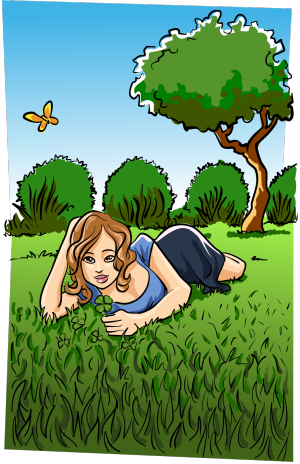
By Paul Wheaton
Lawn care in a nutshell:
- Must do:
- Set your mower as high as it will go (3 to 4 inches).
- Water only when your grass shows signs of drought stress and then water deeply (put a cup in your sprinkler zone and make sure it gets at least an inch of water).
- Fertilize with an organic fertilizer in the fall and spring. I recommend the Ringer brand.
- Have the pH of your soil professionally tested. Add lime if it is below 6.0 and gardener's sulfur if it is above 7.0.
- How much top soil do you have? See how deep a shovel will go into the soil. How deep can you dig a hole in one minute? Four inches of topsoil will make for an okay lawn. Eight or more inches of topsoil will make for a great lawn.
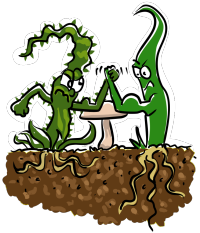 The key to the lawn care game is competition. You want to make things favorable for the grass and unfavorable for the weeds so the grass will choke out the weeds. Naturally.
The key to the lawn care game is competition. You want to make things favorable for the grass and unfavorable for the weeds so the grass will choke out the weeds. Naturally.lawn care must do: mow high
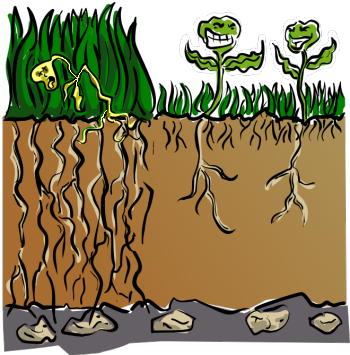
- There is a fight for sun. If the grass doesn't shade the weed, the weed will shade the grass. Sun is food. Food is strength and life. Shade is weakness, disease and death. Grass will shade the weeds only if it is tall enough. The shade of tall, dense grass turf will prevent essential light from reaching most weeds and, will aid in the destruction of new baby weed seedlings (such as the notorius dandelion).
- more shade to the soil leads to less watering
- deeper roots which leads to less watering
- thicker turf which leads to fewer weeds
- slower growth which leads to less mowing
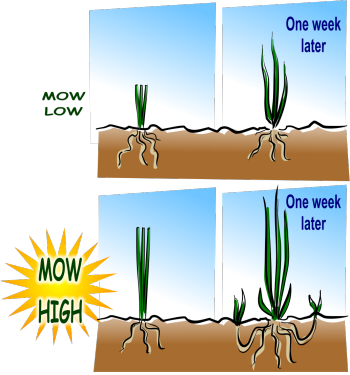 MYTH: "If I mow short, it will be longer until I have to mow again." False! Wrong! (SLAP! SLAP! SLAP!) Your grass needs grass blades to do photosynthesis (convert sunshine into sugar) to feed the roots. When you whack the blades off, the grass has to RACE to make more blades to make sugar. It then grows amazingly fast. This fast growth uses up a lot of the grass's stored sugar, and weakens the plant. It is now vulnerable to disease and pests! Tall grass is healthier and can use the extra sugar to make rhizomes (more grass plants) thus thickening the turf. Have you ever noticed that short grass in the summer is always riddled with dead brown patches? If you have a serious weed infestation, consider mowing twice as frequently as you normally do. The sensitive growing point for grass is near the soil. The sensitive growing point for most weeds is near the top of the plant. So when you mow, it's as if you are giving your grass a haircut and cutting the heads off of the weeds. Finally, when mowing, be sure to leave the clippings on the lawn. It adds organic matter and nutrients back into the soil. If you don't leave the clippings, your soil will begin to look more like "dirt" than soil. Soon it will be a form of cement that nothing will grow in and you will have the world's most pitiful lawn. Some people are concerned about "clumping" - that only happens when you mow too short or when you don't mow often enough. Mowing higher gives the following perks:
MYTH: "If I mow short, it will be longer until I have to mow again." False! Wrong! (SLAP! SLAP! SLAP!) Your grass needs grass blades to do photosynthesis (convert sunshine into sugar) to feed the roots. When you whack the blades off, the grass has to RACE to make more blades to make sugar. It then grows amazingly fast. This fast growth uses up a lot of the grass's stored sugar, and weakens the plant. It is now vulnerable to disease and pests! Tall grass is healthier and can use the extra sugar to make rhizomes (more grass plants) thus thickening the turf. Have you ever noticed that short grass in the summer is always riddled with dead brown patches? If you have a serious weed infestation, consider mowing twice as frequently as you normally do. The sensitive growing point for grass is near the soil. The sensitive growing point for most weeds is near the top of the plant. So when you mow, it's as if you are giving your grass a haircut and cutting the heads off of the weeds. Finally, when mowing, be sure to leave the clippings on the lawn. It adds organic matter and nutrients back into the soil. If you don't leave the clippings, your soil will begin to look more like "dirt" than soil. Soon it will be a form of cement that nothing will grow in and you will have the world's most pitiful lawn. Some people are concerned about "clumping" - that only happens when you mow too short or when you don't mow often enough. Mowing higher gives the following perks: 
lawn mower
- My lawn care mower of choice? The "Scott's Classic" manual mower. When you mow high, it doesn't take much effort to mow. It is easier with a manual than a heavy, noisy, stinky gas mower. The Scott's Classic is the only manual mower that I know of that can mow three inches. The others top out at 2.5 inches or less. It's at amazon.com. Update!
- A recent series of wacky events led me to try a cordless electric mower. Wow! Exceptionally lightweight and quiet! I definitely prefer it over the manual mower. Despite the higher price, I bought one! I like it that much! There is a bigger one with more whizbangery, if that's what you're into.
lawn care must do: water infrequently
- This will force your grass roots to go deep into the soil. Deeper than most weed roots. As the top few inches of soil becomes bone dry, the weeds and weed seedlings up there die while the grass still enjoys moisture from a little deeper. Shallow, frequent watering encourages "thatch" (the grass propogates with above-soil runners (like strawberry runners) rather than rhizomes under the soil - there gets to be so many runners that they weave a mat that chokes out water and air). Since the roots are in the top inch or two of soil, a hot day will quickly dry the soil and much of the grass will brown. Weeds and weed seedlings looooove a daily watering. It's just what they need for a good start. Two methods to tell when it is time to water:
- The grass will start to curl before it turns brown. When it starts to curl, that is the best time to water. Anything after that is time for "intensive care watering" (water half an inch, wait three hours and water an inch).
- Take a shovel and stick it into the soil about six inches. Keep the sun to your left or to your right when you do this. Push the handle forward. If you can see any moisture, wait. If it's all dry, water. If you can't get your shovel to go into the soil this deep, you need more soil.
Lawn Care Fertilizer:
If your lawn is in serious need of fertilizer, use a third of what the package recommends every three weeks in the spring and fall. Otherwise, use half of what the package recommends at the beginning of spring and the beginning of fall.
Cool season grasses are semi-dormant in the summer. Fertilizing in the summer feeds the weeds, not the grass.
If your soil already seems like dirt or cement, add an inch of compost in the early fall. If you can see wood products in the compost sprinkle the Ringer fertilizer on top, otherwise, use only half as much of the Ringer fertilizer. (composts with wood products will feed your lawn for a week or two and then start sucking the nitrogen back out)
I've been getting heaps of e-mail asking about "where do I get the Ringer fertilizer?" I used to get mine at the local home improvement stores. Lately it has been harder to find. But if you need to, try this. I've also talked to people about finding it in thislawn fertilizer discussion thread.
A lot of folks ask about what difference it makes using organic fertilizers in lawn care. Consider a couple of things:
- 1) Ever hear about centuries ago when people would salt the land so nothing would grow? Nearly all chemical fertilizers are a salt. As you use it, year after year, your soil becomes poorer and poorer. 2) Healthy soil is loaded with heaps of microbial and macrobial life. Most of these critters are working hard for your grass. Most of those critters don't like salt.
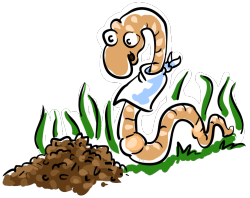 Let's take a quick look at an earthworm. I'm going to call him ... Fernando. Fernando tunnels through the soil, eating as he goes. He gets to the surface and poops out a lot of dirt and digested organic matter. His travels make it so the grass roots get air and water. He eats organic matter like dead leaves and dead blades of grass. He converts them to materials the plants can take up as nutrients. In an organic yard, Fernando takes a decaying blade of grass down in his burrow and munches on it "These things are my favorite!" says Fernando. "I need some more!" Back at the surface, Fernando finds some home made compost "What is this? Oh my! This is my new favorite! (munch munch) It's so good! (munch munch) How can this be crunchy and chewy AT THE SAME TIME! Oof, I'm so full. I wanna have sex and have lots of babies so they can enjoy the crunchy chewy stuff." In a yard that uses chemical fertilizers, Fernando says "AAAIIIIIIIIEEEEEEE!!!! THE PAIN! THE HORRIBLE, HIDEOUS PAIN! I NEED TO GET AWAY FROM IT, BUT IT IS EVERYWHERE! ACK! ACK! HEEEEEELP MEEEEEEE! URK!" (this dramatization brought to you by ... compost! It's yummy!)
Let's take a quick look at an earthworm. I'm going to call him ... Fernando. Fernando tunnels through the soil, eating as he goes. He gets to the surface and poops out a lot of dirt and digested organic matter. His travels make it so the grass roots get air and water. He eats organic matter like dead leaves and dead blades of grass. He converts them to materials the plants can take up as nutrients. In an organic yard, Fernando takes a decaying blade of grass down in his burrow and munches on it "These things are my favorite!" says Fernando. "I need some more!" Back at the surface, Fernando finds some home made compost "What is this? Oh my! This is my new favorite! (munch munch) It's so good! (munch munch) How can this be crunchy and chewy AT THE SAME TIME! Oof, I'm so full. I wanna have sex and have lots of babies so they can enjoy the crunchy chewy stuff." In a yard that uses chemical fertilizers, Fernando says "AAAIIIIIIIIEEEEEEE!!!! THE PAIN! THE HORRIBLE, HIDEOUS PAIN! I NEED TO GET AWAY FROM IT, BUT IT IS EVERYWHERE! ACK! ACK! HEEEEEELP MEEEEEEE! URK!" (this dramatization brought to you by ... compost! It's yummy!)Here is possibly the world's very best lawn fertilizer. I get tons of this stuff for free! Really! Tons! Free! Moldy hay:
lawn care pH:
- Dandelions love a pH of about 7.5. Grass loves a pH of about 6.5. So if your pH is 7.5 or higher, your grass will probably never beat out the dandelion. Lower the pH to 6.5 and your grass has the advantage! Be sure to have your pH tested professionally. The kits that you can buy in the store will often give you the wrong information. I once spent $18 on a pH meter that told me that my lawn pH was 6.0 when it was really 7.8. So I should have added gardeners sulfur, but instead I added lime! Call your local extension office. My local extension office will test pH for free. I've heard of some that charge ten bucks. If you're going to buy a pH tester, be prepared to spend around $85 for the tester and the calibration solutions. A long time ago I bought the Oakton pHTestr 2 plus 4.0 and 7.0 solutions. I looked it up and found it here. I think most folks will wanna keep their $85 and just pack some soil samples to the local extension office. I wrote more on pH here A little side note: a dusting of lime on the soil surface has been shown, in most cases, to nearly double earthworm reproduction.
lawn care soil depth:
- My soil was only half an inch deep. Even weeds had a tough time growing. Below my half inch of soil was huge river rocks seperated by smaller rocks, sperated by sand. It bore no resemblance to soil. I added four inches of topsoil. This was done with two dumptruck loads at $100 a pop. It covered all of the weeds with enough soil that they could not work through - I could start from scratch with my grass seed of choice!
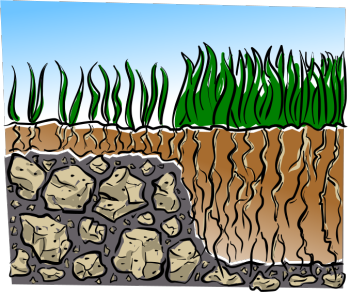 18 inches or more soil would be optimal. I have a friend that has soil this deep. While everyone else waters a dozen times or more over the summer, she waters just once or twice. She uses no fertilizer or pesticides. She has thick, dark green, weed-free grass which requires frequent mowing. Her lawn is about as "no-brainer lawn care" as you could get. This is a good time to talk about soil quality too. There is a big difference between dirt and soil. Soil is rich in microbial life and has a lot of organic matter in it. Dirt comes in many forms and it's a challenge to get anything to grow in it. If you are getting "topsoil" delivered to your house, be prepared for it to bear more resemblance to "dirt". You may want to have compost also delivered to your house so that you can mix the two and have the beginnings for "soil". One part compost to two parts dirt is a good mix for lawn care.
18 inches or more soil would be optimal. I have a friend that has soil this deep. While everyone else waters a dozen times or more over the summer, she waters just once or twice. She uses no fertilizer or pesticides. She has thick, dark green, weed-free grass which requires frequent mowing. Her lawn is about as "no-brainer lawn care" as you could get. This is a good time to talk about soil quality too. There is a big difference between dirt and soil. Soil is rich in microbial life and has a lot of organic matter in it. Dirt comes in many forms and it's a challenge to get anything to grow in it. If you are getting "topsoil" delivered to your house, be prepared for it to bear more resemblance to "dirt". You may want to have compost also delivered to your house so that you can mix the two and have the beginnings for "soil". One part compost to two parts dirt is a good mix for lawn care. lawn care weeds:
- The above lawn care advice will eliminate 95% to 99% of your weed problem. But there are some weeds that are almost impossible to get rid of, no matter what. Some of these are even resistant to the chemical army. The two to be careful of in my area are BINDWEED (looks like white or pink morning glory) and CANADIAN THISTLE. These two have HUGE root systems that might go as deep as thirty feet into the soil. They spread with rhizomes, just like your grass. The above techniques will discourage them enough to go to your neigbor's instead. They don't like tall grass or mowing. They might try to pop up on fences or other lawn borders. Fifty outcroppings could all be part of the same plant, so you really have to get as much of them as you can. The key is to remove the green plant that provides it with sugar. It needs sun and sugar to support that massive root system. Repeated digging will weaken it to the point that bugs and bacteria can take over. I once moved to a house that was infested with both bindweed and thistle. Imagine my yard as a big rectangle. I started pulling weeds on the left and stopped about ten percent of the way across. A few days later, I started at the left again and picked out anything that cropped up in the last few days and then made a little progresss into the rest of the rectangle. Each brief weeding trip gets me another 5% of new territory. The important thing is to always weed the area you already weeded first. If I didn't do it this way, then the weed would recover in the first section while I was attacking another section. DANDELIONS are a sign of alkaline soil. Refer to the pH stuff above. The above methods will prevent dandelions from propogating. Since dandelions live about five years, the mature dandelions will struggle with the tall, thick turf and die off in two to three years. I now think that a few dandelions poking up once in a while are kinda nice and I leave them alone. BLACK MEDIC is a sign of low nitrogen soil. Refer to fertilizing above. The above methods will keep black medic in check. You will occassionally see a little once in a while, but it is kinda pretty when it isn't taking over your lawn. This stuff is sometimes called "yellow clover". When it's taking over, it will choke out grass and make flat mats about a foot in diameter. I found a litte in my current lawn and it was a single tiny strand with little yellow flowers. CLOVER is a sign of low nitrogen soil. Refer to fertilizing above. White and pink clover is often desired in a lawn. It contributes nitrogen to the soil and doesn't compete strongly with the grass. Yellow clover is actually "black medic" (see above). For more on controlling clover, see "getting rid of clover" in our lawn care forum. KNAPWEED tries to poison plants around it with niacin. A little water washes the niacin away and the plants around it can have a fighting chance. Especially if mowing is involved. Mow a little more frequently in late june and early july to wipe out knapweed.
Lawn Care Enhancements:
- Now that you aren't dumping toxic gick on your lawn, you can enhance it with some other growth. CROCUSES: These flowers pop up in the spring while the grass is still dormant. They're done blooming long before the first mow. These are bulbs that are planted in the fall. Go ahead and plant a few dozen right in the middle of your lawn.
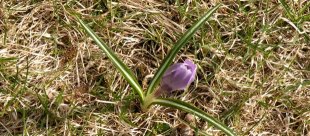 To buy some bulbs, click here ROMAN CHAMOMILE: They look like little daisies. When you mow, it smells like green apples.
To buy some bulbs, click here ROMAN CHAMOMILE: They look like little daisies. When you mow, it smells like green apples.  To buy some seed, click here YARROW: This herb makes your grass extra spongy. It feels really cool to walk on with bare feet.
To buy some seed, click here YARROW: This herb makes your grass extra spongy. It feels really cool to walk on with bare feet.  To buy some seed, click here For more about fun stuff to grow, check our lawn care forum for this thread.
To buy some seed, click here For more about fun stuff to grow, check our lawn care forum for this thread.Lawn Care Summary:
- With these methods you will mow less, water less, never buy pesticides and have the best looking lawn on your block. A little lawn care side trip: Some entertaining perspective on why you should care about how you care for your lawn. Before my master gardener training I thought that herbicide use had a time and place. The training covered not only the time and place, but also covered the details of toxicity. 2-4D is considered one of the safest herbicides. A quantity of 2-4D that would be about the same as a roll of life savers rubbed on the skin of four kindergarten children would kill two of them. This is not getting it in their mouth, but just rubbed on their skin. My reading on this subject has exposed far too many nightmares than I care to share here. My closing opinion is that I can see no time and no place to ever use herbicides. Especially not for anything as frivolous as lawn care. I would rather have weeds. I actively participate in these permaculture forums. And there is a whole forum dedicated to nothing but doing lawn care the way I advocate. Feel free to pop over and ask questions any time.
Lawn Care Providers
I am compiling a list of lawn care providers that fully subscribe to my philosophies and techniques! Please visit my lawn care providers page.Frequently Asked Lawn Care Questions:
- What variety of grass should I plant?
- fertilize and mow high. The fertilizer helps to make more grass. If you have any worms in your dirt/soil, they will take blades of cut grass down lower, munch on it, and leave organic matter down low. The fertilizer helps to make more grass.
- Add an inch of compost every spring and fall. It ain't cheap and it makes your lawn look like crap for a week or so, but again, the worms will work it in.
- I have this weird idea that I have never tried, but I've told several people about in e-mail and have yet to hear back from anybody if they tried it.
- Take a post hole digger and dig a hole about two feet deep. Re-fill the hole with 50% compost and 50% of what you took out of the hole. Stir a little grass seed into the top quarter inch of soil. I think that by doing this, you will create a wonderful home for worms and a great place for deeeeeep grass roots. Over time, the roots and the worms will convert the neighboring dirt into soil. If anybody tries this, I hope you'll write me and tell me how it turned out.
- I recommend "tall fescue". Be sure to check the label and make sure it is pure tall fescue. Some outfits that sell seed mix in some annual ryegrass and call it "nursury grass - it will care for the tall fescue which takes longer to germinate." I don't agree with that. Note that tall fescue seed is significantly more expensive than annual ryegrass ... Tall fescue makes deeeeeep roots and is one of the most drought tolerant species. Combining this species of grass with the infrequent watering makes it one of the best lawn care species for fighting weeds. It also means you can have a lovely lawn using less water. Tall fescue is one of the most durable grasses. It stands up well to the abuse of football games and pets. It will also stand proud at three inches, four inches and five inches! Kentucky Bluegrass starts to waver at three inches. Tall fescue does well in shade and sun! Downsides of tall fescue:
- It is slow to germinate. It could be two weeks until you see the baby grasses. In the meantime, weed seeds have probably germinated. Some people think it is not the prettiest type of grass. The fine fescues (very different from tall fescue) have thin blades and the tall fescues have broad blades. I have to admit that a lawn with the fine blades does look better - as long as nobody ever walks on it. But who wants grass that you're not allowed to walk on? Some people think that tall fescue doesn't feel as good under bare feet. This is true. Tall fescue is a stiffer grass. The grasses that feel better are the ones that won't compete with weeds as well. Besides, I think most folks won't notice the difference in feel between tall fescue and Kentucky Bluegrass.
- Nearly every county in the United States has a county extension office. The word "extension" means that the office is an extension of the the state agricultural school. This office is staffed by people who are paid to answer questions about plant life in the county (including lawns). If people don't call, they could lose their jobs! Call! Ask lots of questions! Visit! Take weed samples to them for identification! Bugs too! Sometimes the phones are manned by volunteers. Folks that love gardening and horticulture so much, that they are itching to share their lawn care expertise with you. Many of these folks have completed the master gardener training offered by the extension office. If nothing else, a visit to the office can be worthwhile because they have loads of brochures about issues in your area. To find them, open your phone book to "the blue pages" (government listings) under "County Government" and look for "Extension Office", "Extension Agent" or "County Extension".
- Grubs are the larvae of certain species of beetles. Grubs think grass roots are yummy. If you dig up dead patches of grass you just might see a bunch of grubs munching away. This is where birds are your friends. Birds think grubs are yummy. I have never had to personally deal with grubs. And I have yet to encounter an organic grower that has had to deal with them. But I have had many people write to me and ask how to deal with grubs organically. Nearly all of them have mentioned "Last year I sprayed toxic goo to get rid of the grubs and now they're back". While I did not see what happened, my guess is that birds and other natural grub control ate the dead grubs and died. No more natural grub control. So the trick is to kill the grubs, but don't harm anything that eats grubs. The answer is to bring in more grub predators. Having done a little reading on this topic, "Milky Spore" (Bacillus popilliae) and/or predatory nematodes appear to be the organic control. "Milky Spore" is a naturally occuring bacteria that makes the grubs puke their guts out, but it doesn't seem to bother anything else. So if a bird eats a dead grub, the bird will be fat and happy. Predatory nematodes (also called "beneficial nematodes") are like micro worms that crawl through the soil and eat a variety of different organisms, including grubs. Here it is for sale: click here
- If you have an inch of "dirt" and everything under that is big rocks or rock-hard clay, improving your "dirt" isn't going to make much difference. You are probably going to need to import some top soil. If you have the bucks, you can have a foot and a half of topsoil dropped on your existing lawn and then plant new grass seed and start over. Soil on top of dirt ain't bad. If you have patience and think that your dirt can be renovated into soil, you can:
- People that are trying to grow mushrooms will provide the mushrooms with rotting sawdust or rotting logs. Generous moisture and a lack of direct sunlight can help too. In the horticultural world "rot" almost always mean "composting". To properly compost, you need a certain mixture of carbon heavy organic matter (wood, dried leaves, straw, etc.) and nitrogen heavy organic matter (manure, grass clippings, table scraps, weeds, etc.). If you get just the right mix, you get hot composting happening. Too much nitrogen and it gets a little stinky. Too much carbon and the composting takes a very long time. To get rid of mushrooms, you just need to get your lawn to outcompete them. Grass loves a nitrogen rich soil. Mushrooms love a carbon rich soil. Lawn fertilizer has heaps of nitrogen and hardly any carbon. Time to fertilize! Twenty bucks and ten minutes of time will do wonders for your lawn care strategy. Here's something that can be a kick: take a close look at your mushrooms. If there are a bunch of them, are they growing in a circle? If so, this is called "fairy ring". The ring will grow larger and larger as the spores from the current mushrooms land just outside of the ring. Consider for a moment that if you have a lot of mushrooms in your lawn, this is most likely a sign that you have really excellent soil! Further, the mushrooms you see are the fruiting bodies of a much bigger fungus organism under the soil. Most fungus organisms help your grass be healthier - so I'm usually glad to see a few mushrooms in my lawn now and then. The mushrooms are usually gone as soon as things dry out a bit. For more on getting rid of mushrooms, see "mushrooms on lawn" in our lawn care forum.
- Dog poop and dog pee are both high in nitrogen. But if you give your lawn too much nitrogen, you'll kill it. Not the whole lawn. Just the spot with too much nitrogen. Usually there will be a load of dog poop and the grass under it will be dead. And the grass immediately around it will be greener, taller, thicker and healthier than all the rest of the lawn. So the stuff immediately under the crap is "too much" and the stuff surrounding the crap is "optimal". Same thing for pee only there won't be a pile of poop in the middle. Solution 1
- This solution is reserved for the Zen Masters of the school of the cheap and lazy lawn care. Do nothing. For dog pee, the grass is tall enough that it hides the dead spot. Rain and irrigation will eventually rinse enough nitrogen out that they grass will grow back into that spot. I leave the poop to the worms and the microbials in the soil. Birds will also work it over a bit (looking for the worms and other bugs attracted by it). How quickly the poop disappears on its own shows how healthy your lawn is. Just be careful not to step on the fresh stuff. An added benefit is that you can remain on great terms with your neighbors. If your spousal unit says "go clean up that dog crap in the yard!" You can now say "I looked it up on the internet and it said the best solution was to leave it!"
- Sprinkle a little sawdust on the spot and give the spot a little attention from your hose. The sawdust will hide the poop and it will counter the excess nitrogen. Combining with the nitrogen, it will, in time, turn into compost - enriching the soil. The sawdust will also reduce any odor by about 95%. The water will wet the sawdust and dilute the nitrogen source a bit, thus helping the beginning of the composting process.
- Remove the poop, dig an inch into the soil and mix sawdust into the soil. This is the same as solution 2, but the sawdust will be more effective this way.
- Remove the poop and an inch of affected soil. Replace with compost and some grass seed. A lot of people do this. I think it's pretty dumb. I think that removing the dog poop and watering the area is more effective than this. The water will dilute the excess nitrogen in the soil. The surrounding grass will spread into the area using grass rhizomes. There is no need for seed. If you put seed here, you will be saddling yourself with the responsibility of watering it every day for two weeks. Reading the rest of this lawn care essay will tell you that that's a great way to get weeds. Plus, it's work! Now let's look at the compost: compost is wonderful, magical stuff. But in this case, you've just added nitrogen to an excess nitrogen problem. Further, seeds don't germinate well in a high nitrogen medium like compost. The germinate better in something like pH adjusted peat moss. Or plain topsoil. The plants like nitrogen after they've gotten past the seedling stage.
- Don't. I mean it. Put overseeding out of your mind. Your "dirt" has such terrible issues that adult grass is struggling to survive and now you want to put babies there? I am, right now, trying really hard to think of one case where overseeding will do any good for any lawn care situation .... nope - can't think of a single case. Seeding bare patches that are are at least a foot or two wide makes sense - but that's not "overseeding" (tossing seed onto an existing patch of grass). Improve your soil and your existing grass will thrive. Then there is no need for seed. Please take a look at this thread of discussion I've been in on overseeding in our lawn care forum.
This article was originally published at Permies.com by Paul Wheaton.























